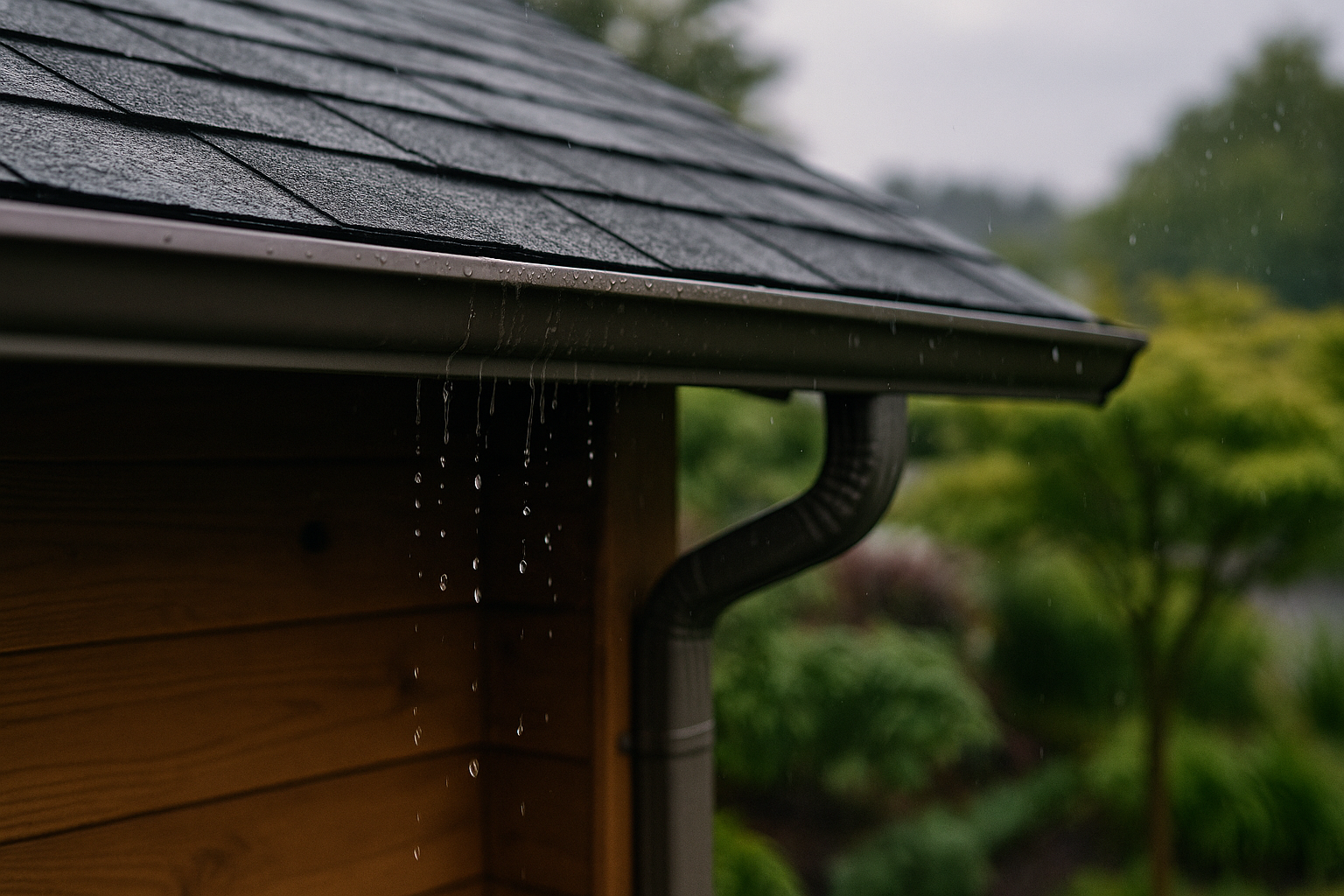Choosing the right gutter size keeps rainwater moving away from your home instead of into your foundation, landscaping, or siding. This guide explains how gutter sizing works, gives a practical sizing chart, walks through a clear math example you can reproduce, and shows how to match gutters (and downspouts) to roof area and local storm intensity.
Quick answer
-
5-inch K-style gutters are the standard choice for most single-family homes and handle typical roof areas and moderate rainfall.
-
6-inch K-style gutters are safer for large roofs, long roof runs, steep pitches, or heavy-rain areas.
-
Use more downspouts rather than undersizing gutters — extra downspouts reliably increase capacity.
-
Half-round and box gutters have different capacities and aesthetic trade-offs; choose by function and design.
-
Always consider local rainfall intensity (design storm) — higher inches/hour needs bigger gutters or extra downspouts.
How gutter sizing actually works (simple, practical model)
-
Measure roof area that drains to the gutter. This is typically “roof length × eave length” for each roof plane, or the plan area that feeds the gutter.
-
Pick a design rainfall rate (inches per hour). Typical design rates for guidance: 1.0 in/hr (light–moderate), 2.0 in/hr (heavy), 3.0+ in/hr (very heavy or short, intense storms). Check local code or weather data for exact design storms.
-
Convert runoff to flow (gallons per minute) using a simple formula (shown below).
-
Choose downspout capacity (how many gallons per minute a downspout will carry) and size the number of downspouts and gutter size accordingly.
The basic runoff formula (step-by-step)
You can calculate the flow rate your gutters must handle.
Formula (step-by-step):
-
Roof area AAA in square feet (sq ft).
-
Rainfall intensity RRR in inches per hour (in/hr).
-
Volume per hour (cubic feet per hour) = A×R12A \times \dfrac{R}{12}A×12R.
-
Reason: 1 inch = 1/121/121/12 foot, and volume = area × height.
-
-
Convert cubic feet per hour to gallons per hour (multiply by 7.480527.480527.48052).
-
Convert to gallons per minute (divide by 606060).
Combined simplified formula (for GPM):
GPM=A×R×0.01039\text{GPM} = A \times R \times 0.01039GPM=A×R×0.01039
(where 0.01039=7.4805212×600.01039 = \dfrac{7.48052}{12 \times 60}0.01039=12×607.48052).
Example (walkthrough): Roof area = 2,000 sq ft, design rain = 1.0 in/hr.
-
Step 1: A=2,000A = 2{,}000A=2,000.
-
Step 2: R=1.0R = 1.0R=1.0.
-
Step 3: Multiply A×R=2,000×1.0=2,000A \times R = 2{,}000 \times 1.0 = 2{,}000A×R=2,000×1.0=2,000.
-
Step 4: Multiply by 0.010390.010390.01039: 2,000×0.01039=20.782{,}000 \times 0.01039 = 20.782,000×0.01039=20.78.
-
Result: ≈ 20.8 gallons per minute (GPM) of runoff in a 1.0 in/hr storm.
If you expect heavier storms (for example R=2.0R = 2.0R=2.0 in/hr), the flow doubles: 2,000×2.0×0.01039=41.562{,}000 \times 2.0 \times 0.01039 = 41.562,000×2.0×0.01039=41.56 GPM.
Typical downspout capacities (industry rule-of-thumb)
Downspout capacity depends on shape, outlet height, and slope. Use these typical working assumptions (common industry approximations):
-
2″ × 3″ rectangular downspout ≈ 10–12 GPM (conservative).
-
3″ × 4″ rectangular downspout ≈ 18–24 GPM (conservative).
-
4″ round downspout ≈ 20–30 GPM depending on slope and length.
These are approximate. Use the higher numbers if your downspouts are short and vertical; use the lower end if there are long horizontal runs or partial obstructions.
Using the example: For 20.8 GPM (2,000 sq ft @ 1.0 in/hr), you would need either:
-
One 3×4 downspout (≈ 18–24 GPM) — fits but is near the lower limit, or
-
Two 2×3 downspouts (2 × 10–12 GPM = 20–24 GPM) — more conservative and recommended.
Practical gutter sizing chart (use as a guideline)
This chart gives practical, conservative recommendations. It assumes a typical single eave/run feeding the gutter, a design rain of 1.0 in/hr (adjust by multiplying GPM if you design for heavier storms). If your location sees heavier short-term intensity (e.g., 2.0 in/hr), double the GPM values and add downspouts.
| Roof area feeding a single gutter run | Typical gutter choice | Typical downspout recommendation (conservative) |
|---|---|---|
| up to 800 sq ft | 5″ K-style or 5″ seamless | 1 × 2×3 downspout (10–12 GPM) |
| 800–1,200 sq ft | 5″ K-style (consider extra downspout) | 1 × 3×4 or 2 × 2×3 downspouts |
| 1,200–2,000 sq ft | 6″ K-style or 6″ seamless recommended | 1 × 3×4 (best) or 2 × 2×3 (safer) |
| 2,000–3,000 sq ft | 6″ K-style or half-round / box | 2 × 3×4 downspouts or 3 × 2×3 |
| 3,000+ sq ft / commercial | Box gutters or multiple 6″ gutters | Engineered solution (multiple large downspouts) |
Notes:
-
If your house has unusually long runs between downspouts, add extra downspouts even if the table suggests 1.
-
For heavy rain areas (use design storm R=2.0R = 2.0R=2.0 or higher), multiply required capacity by 2 (or more) — choose the next larger gutter size and/or add downspouts.
Why choose 5-inch vs 6-inch gutters?
-
5-inch gutters (K-style, seamless) are the most common because they balance cost, appearance, and capacity for typical single-family homes. They’re usually adequate if your roof area per downspout is moderate and local storms are not extreme.
-
6-inch gutters give about 25–50% more capacity (depending on profile) — they’re recommended for:
-
Larger roof areas or wide eaves,
-
Long gutter runs with fewer downspouts,
-
Regions with heavy, intense rainfall, or
-
Steeper roof pitches that concentrate flow into valleys.
-
-
Half-round gutters often carry more water per linear foot than similarly sized K-style gutters and are easier to clean, but cost more and are a different architectural look.
-
Box gutters are used where large volumes are expected (commercial, or when gutters are built into a parapet). They’re an engineered product.
Gutter slope, pitch, and why it matters
-
Recommended slope: generally 0.25″ to 0.5″ drop per 10 ft of gutter toward the downspout (about 1/4″ per 10′). This helps water flow and prevent standing water.
-
Too little slope → standing water, debris buildup, mosquito issues.
-
Too much slope → water can outrun the downspout entry, causing splash or overflow; also looks odd.
-
For long gutter runs use multiple downspouts rather than excessive slope adjustments.
Seamless gutters vs sectional, and profile choices
-
Seamless gutters (on-site roll-formed) minimize leak points and often perform better over decades.
-
Sectional gutters are cheaper but have more joints and more potential leak/maintenance points.
-
K-style is the default aesthetic for many modern homes; half-round suits historic or craftsman styles; box gutters for heavy commercial duty.
Practical tips and pitfalls
-
Add downspouts early. If in doubt between adding an extra downspout or upsizing the gutter by one inch, add the downspout. It’s usually cheaper and more effective.
-
Avoid under-sized downspouts. A single undersized downspout is a common cause of overflow at heavy rainfall.
-
Protect landscaping. Direct downspout discharge away from plantings and foundations using extensions, French drains, or daylighting.
-
Think maintenance: Larger profiles like half-round can be easier to clean; seamless reduces leaks.
-
Local code & HOA: Check local building code and HOA rules — some jurisdictions specify minimum sizes or downspout spacing.
Example calculation you can run in minutes
-
Measure roof area that flows to one gutter: A = 1,500 sq ft.
-
Choose design storm: R = 1.5 in/hr (heavy local event).
-
Calculate GPM:
-
Multiply: A×R=1,500×1.5=2,250A \times R = 1{,}500 \times 1.5 = 2{,}250A×R=1,500×1.5=2,250.
-
Multiply by 0.01039: 2,250×0.01039=23.382{,}250 \times 0.01039 = 23.382,250×0.01039=23.38 GPM required.
-
-
Match downspouts: 23.38 GPM ≈ one 3×4 downspout (≈ 18–24 GPM) — borderline. Safer option: two 2×3 downspouts (≈ 20–24 GPM combined). Consider using 6″ gutters plus two downspouts for extra headroom.
Maintenance & long-term performance
-
Clean gutters twice a year in leafy areas; in heavy-needle climates consider micro-mesh guards.
-
Inspect after storms for clogs, loose hangers, and sagging.
-
Magnetic sweep under the roofline after installation to remove nails from lawns.
-
Keep downspout outlets clear and directed away from the foundation (pop-up emitters, flexible extensions, or buried lines).
Quick FAQ
Q — Are 6-inch gutters always better?
A — Not always. They cost more and can look bulky. But for large roofs, heavy rain, or long runs, 6-inch gutters provide safer capacity and reduce overflow risk.
Q — How many downspouts should I have?
A — Minimum two for most houses. For every additional 1,000–1,500 sq ft of roof area (depending on rainfall design), add an extra downspout or upgrade to a 3×4.
Q — Are half-round gutters better than K-style?
A — Half-round often has better flow per inch of width and easier cleaning, but it’s costlier and different in look. For high-flow or historic aesthetics, half-round is excellent.
Q — Should I use seamless gutters?
A — Yes for fewer leaks and a cleaner look. They cost more upfront but reduce maintenance.
Final checklist — choose the right system for your home
-
Measure roof area that drains to each gutter run.
-
Find local design rainfall (in/hr) or use 1–2 in/hr as conservative planning values.
-
Use the runoff formula (GPM = A × R × 0.01039) to calculate required flow.
-
Select downspout capacities and number of downspouts to meet or exceed required GPM.
-
Pick gutter profile (5″ vs 6″ K-style, half-round, box) that matches capacity, budget, and aesthetics.
-
Confirm gutter slope, spacing, and protect landscaping with proper discharge.
-
Consider seamless gutters and more downspouts for long usable life and fewer clogs.
 Call Now
Call Now Get In Touch
Get In Touch

